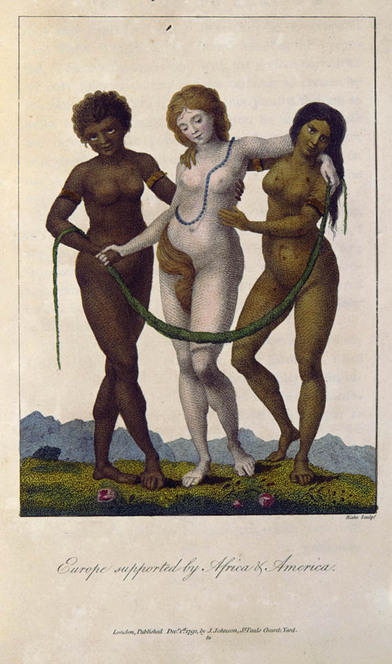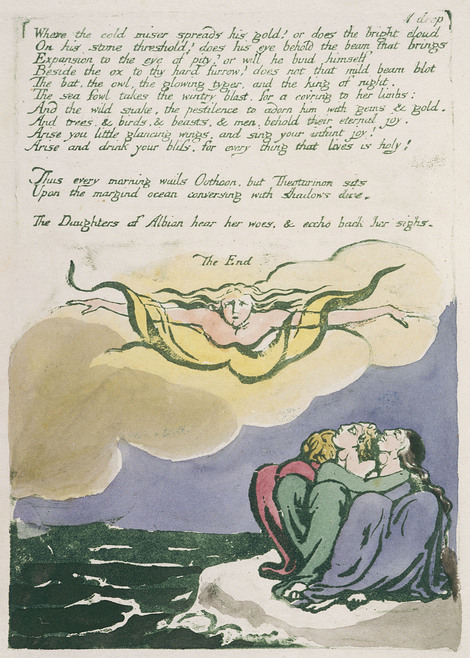In addition to my position as a project assistant at the Blake Archive, I teach in the Art Department at UNC Chapel Hill. This fall I am teaching an advanced undergraduate course called “Art in an Age of Revolution” that surveys visual culture of Europe and the Americas from the middle of the eighteenth century to the July Revolution of 1830. From the beginning of the semester, I have encouraged my students to draw thematic connections between the historical material presented in class and contemporary discourse on revolution and politics at large. On Tuesday morning, with Sunday’s presidential debate still fresh in everyone’s minds, a class discussion that began with Blake’s designs for John Gabriel Stedman’s Narrative of a Five Years Expedition against the Revolted Negroes of Surinam grew into a debate on contemporary rhetoric about sexual consent and the intertwined issues of empathy and difference, particularly in relation to protests like the Black Lives Matter movement.


John Gabriel Stedman, Narrative, of a Five Years’ Expedition, against the Revolted Negroes of Surinam, 1796, object 2, “A Negro hung alive by the Ribs to a Gallows” (left) and object 8, “Flagellation of a Female Samboe Slave” (right), William Blake Archive.
Before class, for context, I had asked my students to read Marcus Wood’s chapter, “John Gabriel Stedman, William Blake, Francesco Bartolozzi, and empathetic pornography in the Narrative of a Five Years Expedition against the Revolted Negroes of Surinam,” in the 2003 edited volume by Geoff Quilley and Kay Dian Kriz, An Economy of Colour: Visual Culture and the North Atlantic World, 1660-1830. In the chapter, Wood not only explains the historical context for these images in colonial Surinam but also argues, provocatively, that Blake’s designs are in fact pornographic. Expanding Lynn Hunt’s influential study of pornography to include the colonial, black body, Wood identifies pornography through three presences: sexual elements; a dehumanized victim in scenarios of penetration, pain, or degradation; and elements that endorse such abusing/dehumanizing behavior. Blake’s designs for The Narrative, Wood argues, are beautiful, pornographic images of eroticized torture. Moreover, Wood draws on Stedman’s textual and author portrait to propose that though the black body was the site of the physical pain, eighteenth-century theories of moral sentiment elevated an individual’s capacity for empathy, or experiencing another’s pain, as the supreme test of humanism. Thus, Blake’s designs for Stedman’s Narrative function as “empathetic pornography” through which the viewer can fantasize about torture (and underscore his humanism through this capacity for empathy) while displacing, and dehumanizing, the suffering of the black body.

Captain John Gabriel Stedman, National Maritime Museum, Greenwich, London. The text accompanying the author portrait proclaims: “From different Parents, different Climes we came, At different Periods; ‘Fate Still rules the same.’ Unhappy Youth while bleeding on the ground, ‘Twas Yours to fall – but Mine to feel the wound.”
Now, back to my class. Students immediately commented on the connection between Wood’s definition of pornography as images in which consent is absent—and in which this absence is endorsed—to the debate about consent now embroiling Donald Trump after the release of a conversation from 2005 in which he brags about groping women. Another student paralleled Trump’s visual and economic consumption of women, using the example of the pageants he owned, with the visual consumption of the sexualized female body in Blake’s designs, most notably “Europe Supported by Africa & America.”

John Gabriel Stedman, Narrative, of a Five Years’ Expedition, against the Revolted Negroes of Surinam, object 16, “Europe supported by Africa & America,” William Blake Archive.
But a student then asked, “Wasn’t Blake an abolitionist? And wanted more equal rights for women?” Yes, I answered, most evidence suggests that he supported both, and his designs for Stedman were circulated repeatedly in support of abolition. “But how we can avoid looking at these images as pornographic and dehumanizing in subject, even if they helped the cause?” another student asked. My students and I agreed that we didn’t have a definitive answer.
So is there a way to “understand” the experience of someone else without displacing or commandeering that individual’s unique experience? I posed this question to my students. One student volunteered that it reminded her, a white student, of participating in a Black Lives Matter protest in which organizers asked participants who were not black to defer journalists’ questions to participants who were. We then grappled with the question of speech and who can, in fact, speak for another. Again, none of us settled on a satisfactory answer. But the discussion’s new focus on speech proved fortuitous for me—I had included images from Blake’s Visions of the Daughters of Albion as my final slides for the day.

Visions of the Daughters of Albion, copy I, object 11, 1793
We considered Visions’ narrative in relation to Stedman’s and the fact that Blake worked on the both projects in the 1790s. But the final lines proved the most interesting since, unlike Stedman, Blake gives voice to his oppressed protagonist, Oothoon, at the end of the book: “Thus every morning wails Oothoon. but Theotormon sits/ Upon the margind ocean conversing with shadows dire,/ The Daughters of Albion hear her woes, & eccho back her sighs” (12-14). Although Blake leaves the outcome murky, he nonetheless makes clear Oothoon is being heard even if only by her similarly oppressed Daughters of Albion. Yet, as my students and I agreed, ending with Oothoon’s wails seems not only like an apt conclusion but also a promising start for thinking about who can (and should) speak on experiences of oppression.

Doubtless Blake, a man of intense empathetic imagination, was powerfully aware of the erotic aspect of torture and cruelty, and this is possibly reflected in the first two drawings. Generally it was his obsession with the idealised human form, i.e. the human form as it appeared most beautifully in his imagination, both male and female, and the years of artistic labour he spent mastering its representation, that compelled him to draw and paint the naked body over and over. The naked human being was of course to him the microcosm, that is, a profound symbol with indefinite horizontal and vertical correspondences throughout manifest nature or the macrocosm (hence the depiction of the continents as women) not simply an object of sexuality or sexual desire. Interpreting Genesis, he believed it was only the Fall of humanity into ego and base consciousness that had reduced human beings to perceiving themselves primarily in a sexual manner, rather than in their native glory as a finite image of the infinite. In that sense, an interpretation of his work as pornographic is quite possibly the shallowest that could be imagined. Blake would have found the notion that drawing them naked dehumanised women utterly ridiculous. He would almost certainly have said that fashion, the pomp of clothes, truly dehumanised women and that representing them naked was a celebration of their humanity divine.